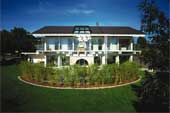Essay Part 1 | Essay Part 2 | Essay Part 3
It is generally supposed that the British can only tolerate a new home, provided that it looks old. A new build must ape the architecture of the Elizabethan, the Georgian or the Victorian eras, or, at the very least, it must incorporate at least one feature of these styles. There is no need to integrate this feature with the rest of the structure: a Neo-Classical doorway suggests taste and gracious living, any time,any place, anywhere. However, this may now be an oversimplified view of public taste. The aversion remains for the stained 1960s commercial and residential blocks that scar our cities, but there are signs of a new willingness to embrace the contemporary, either as a living space, or as a national monument. The row over which statues should fill the plinths of Trafalgar Square alongside Nelson's Column should not overshadow the acceptance of structures, domestic and public, that not so long ago would have raised a chorus of dismay. The Gherkin, 30 St Mary Axe, is now established as one of the sights of London, a Nelson's Column in the east. Last month I stood in the surprisingly restrained foyer of this building and looked out on the passers by looking in and then up towards the dome. There was no hostility, just admiration - probably not of its sustainable credentials (the way in which the double skin reduces heating and cooling requirements, for instance) but of its grace, power and presence. 30 St Mary Axe is considered an adornment to the skyline of the capital, rather than a 40-storey black and silver intrusion.
Some weeks before, I had also stood in the long queue to view a Huf Haus, one of the now famous timber framed prefabs that had been built in the grounds of a design exhibition in London Docklands. The conversations around me revealed an eager curiosity about what life would be like in such a home, with its super-sized windows and an utter absence of original features. A husband in the queue who was failing to appreciate the finer points of post and beam architecture and contemporary prefabricated build methods was rebuked by his wife who told him: "If your mother's going to be having a Huf Haus, you'd better learn to understand them." Note that she did not say 'like them', acknowledging that to learn to love a new build you may first have to grasp how its design and use of technology can make life more comfortable. More evidence of this new willingness to at least understand the merits of the contemporary can be seen in the large number of visitors to Modernism 1914-1939 - Designing a New World, the recent show at the Victoria & Albert. This exhibition, curated by Christopher Wilk, provided a guide to the beliefs of Mies van der Rohe, Marcel Breuer, Le Corbusier and the rest, explaining how their designs moved "from the sketchboard to the real world", reinventing the look of buildings by stripping away ornament in a veneration of the mechanistic.
The Modernist masters may have been indirectly responsible for the shape and style of the stained and unlovely slab office block in your city centre and the sprawling housing schemes on its outskirts. But the Modernism show made it clear that the ideals of the masters had been traduced. It was their ambition to promote domestic ease and convenience, not the sense of isolation and fear associated with life in a multi-storey block: they wished to build "vertical garden cities", not sink estates.
Back to top
Essay Part 1 | Essay Part 2 | Essay Part 3 |
Assessor's report
Essay
Awards committee
Order Winners Book
![]()
Awards 2005
Awards 1997-2004
Background
Sponsors
How to enter
Judging criteria
Contact us
Home

